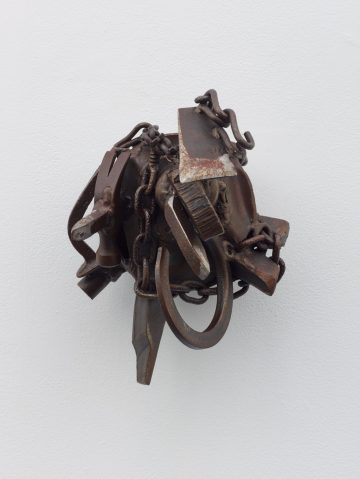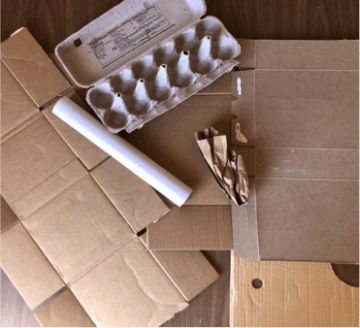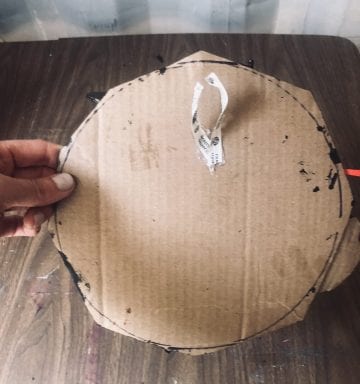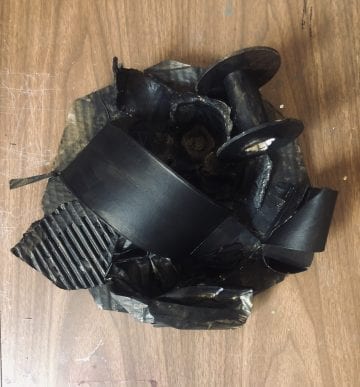Español abajo.
This activity introduces students to a dynamic living African American artist who uses found objects and traditional blacksmithing techniques to create high and low relief sculptures. Students will learn about the significance of the artist’s travels to Africa and how his time living and working there has influenced his artwork. Students will create their own hanging sculptures using cardboard, a hot glue gun, and black and metallic paints.
Download Activity
Melvin Edwards, Angola, 1992. Welded steel | Melvin Edwards, Angola, 1992, acero soldado
Melvin Edwards was born in 1937 in Houston, TX. He is still living at 84 years of age and is considered a pioneer in the history of contemporary African American art and sculpture. He traveled to California to pursue college on a football scholarship, but instead found a new passion, welding and making sculpture! He began his artistic career at the University of Southern California (USC) in Los Angeles, CA, where he met and was mentored by the Hungarian painter Francis de Erdely. In 1965, the Santa Barbara Museum of Art, CA organized his first solo exhibition, which launched his professional career. Edwards moved to New York City in 1967 and, shortly after his arrival, his work was exhibited at The Studio Museum in Harlem. In 1970, he became the first African American sculptor to have a solo exhibition at the Whitney Museum of American Art.
SUPPLIES
- A variety of cardboard (thick and thin), heavy paper scraps, toilet paper rolls, other interesting and malleable cardboard pieces.
- Heavy duty scissors and/or a safe utility blade (younger students need supervision while using this tool)
- Small glue gun and glue sticks
- Black and/or metallic paint
- Paint palette and water cup
- Paint brushes
PROCESS
- Ask students to consider a place that is significant to them. What are some landmarks or aspects of this place that make it special or unique? How can you capture some of those details in the shapes you add to the sculpture?
- Ask your students if they have ever created a work of art using found objects before.
- Ask students to start by cutting out a larger base from a thicker piece of cardboard
- Have students gather and play with the cardboard and whatever other paper-based materials they have brought to the table.
- Once students have found a collection of objects that are working together, have them use the hot glue gun to glue all of the shapes down. Encourage them to consider which objects overlap, bend, twist, or rise above or below other objects. Ask students to create objects that are both in low and high relief, i.e some shapes are closer to the base while others are further away.
- Remind students to consider the relationship between background, middle ground and foreground, and how this plays into their sculpture. What objects move forward, which ones fill the middle space, which shapes are closest to the viewer?
- Once students have a significant amount of pieces glued down ask them to paint over the entire piece with black or a dark color paint. Watering down the paint will make it spread easier and more quickly on the first coat.
- Let the sculpture dry and then add a layer of metallic paint
- Ask students to turn the sculpture around in front of themselves and choose an orientation that they like best. Once they have chosen the orientation, have students glue a small string or wire, in a loop, on the back so it can hang on a wall.
- Ask students to glue a string or wire to the back of the sculpture in a loop. Sign and date the back of the sculpture.
KEY TERMS
Sculpture is the art of making two- or three-dimensional representative or abstract forms, especially by carving stone or wood or by casting metal or plaster.
Abstraction is a non-realistic style of art that uses colors, lines and shapes to express emotions and ideas.
A Blacksmith is a metalsmith who creates objects from wrought iron or steel by forging (to make or shape (a metal object) by heating it in a fire or furnace and beating or hammering it) or the metal, using tools to hammer, bend and cut.
Form as an element of art is three-dimensional and encloses space. Like a shape, a form has length and width, but it also has depth. Forms are either geometric or free-form.
Angola is a country in northwest Africa between Namibia and the Democratic Republic of Congo. Angola is also the name of the infamous Louisiana State Penitentiary, which is named “Angola” after the former plantation that occupied this territory. The plantation was named for the African country that was the origin of many slaves brought to Louisiana.
Found object is a natural or man-made object, or fragment of an object, that is found (or sometimes bought) by an artist and kept because of some intrinsic interest the artist sees in it.
Relief means a sculpture is on a flat surface and not “in the round”. A relief sculpture is able to be hung on the wall, against its flat surface as opposed to a free-standing sculpture, which is viewable on all sides. High relief means that the forms are carved quite deeply and cast strong shadows. Low relief is smoother, flatter and shows less contrast of lit and shadowed areas.



________________________________________________________________
ACTIVIDADES ONLINE DEL MUSEO OGDEN PARA EL AULA: ANGOLA I MELVIN EDWARDS | 5-12vo GRADO
Esta actividad les presenta a los alumnos a un artista afroamericano con una vida dinámica que utiliza objetos encontrados y técnicas de herrería tradicionales para crear esculturas de alto y bajo relieve. Los alumnos aprenderán acerca de la importancia de los viajes del artista a África y cómo el tiempo en que vivió y trabajó allí influenció su obra. Los alumnos crearán su propia escultura colgante utilizando cartón, una pistola de pegamento y pinturas negras y metalizadas.
Descargar Actividad
Melvin Edwards, Angola, 1992. Welded steel
Melvin Edwards nació en 1937 en Houston, Texas. Todavía vive a sus 84 años y es considerado un pionero en la historia del arte y la escultura afroamericana contemporánea. Viajó a California para ir a la universidad, gracias a una beca de fútbol americano, pero en su lugar, encontró una nueva pasión: ¡soldar y hacer esculturas! Comenzó su carrera artística en la Universidad del Sur de California (USC) en Los Ángeles, California, donde conoció y fue instruido por su mentor, el pintor húngaro Francis de Erdely. En 1965, el Museo de Arte de Santa Bárbara, en California, organizó su primera exposición individual, la cual hizo despegar su carrera profesional. Edwards se mudó a la ciudad de Nueva York en 1967 y, poco después de su llegada, su obra fue exhibida en el Studio Museum en Harlem. En 1970, se convirtió en el primer escultor afroamericano en tener una exhibición propia en el Museo Whitney de Arte Americano.
MATERIALS
- Cartones varios (gruesos y finos), recortes de papel grueso, rollos de papel higiénico y otras piezas de cartón interesantes y maleables.
- Tijeras industriales y/o un cúter (los alumnos más pequeños requerirán de la supervisión de un adulto a la hora de usar esta herramienta)
- Pistola de pegamento pequeña y pegamento en barra
- Pintura negra y/o metalizada
- Paleta de pintura y taza para colocar agua
- Pinceles
PROCEDIMIENTO
- Pídeles a los alumnos que piensen en un lugar que sea importante para ellos. ¿Qué aspectos de este lugar lo hacen único y especial? ¿Cómo pueden plasmar alguno de estos detalles en formas que puedan añadir a la escultura?
- Pregúntales a tus alumnos si alguna vez crearon una obra de arte utilizando objetos encontrados.
- Pídeles a los alumnos que comiencen cortando la base de una pieza de cartón gruesa.
- Pídeles a los alumnos que se junten y jueguen con el cartón y cualquier otro material de papel que hayan traído a la mesa.
- Luego de que los alumnos hubiesen encontrado una colección de objetos que funcionen en su conjunto, pídeles que utilicen la pistola de pegamento para pegar todas las formas entre sí. Pídeles que piensen qué objetos se superponen, se doblan, se tuercen o se elevan por sobre o por debajo de los demás objetos. Pídeles a los alumnos que creen objetos que tengan alto y bajo relieve, es decir, algunas formas estarán más cerca de la base y otras estarán más lejos.
- Recuérdales a los alumnos la relación entre fondo, plano medio y primer plano y cómo esto entra en juego en su escultura. ¿Qué objetos se mueven hacia adelante, cuáles rellenan el plano medio y qué formas están más cerca del observador?
- Luego de que los alumnos hubieran pegado una cantidad importante de piezas, pídeles que pinten toda la obra con una pintura negra u oscura. Diluir la pintura con agua facilitará la rápida distribución de la pintura en la primera mano de pintura.
- Deja que la escultura se seque y luego añade una capa de pintura metalizada
- Pídeles a los alumnos que giren la escultura y decidan qué orientación les gusta más. Luego de haber elegido la orientación, pídeles a los alumnos que peguen en la parte de atrás de la escultura una pequeña cuerda o alambre, en forma de bucle, para que puedan colgarla en la pared.
- Haz que los alumnos firmen la escultura y le pongan la fecha en la parte de atrás.
TÉRMINOS IMPORTANTES
Escultura: es el arte de representar objetos o crear figuras abstractas en dos o tres dimensiones, trabajando o labrando un material como piedra, madera, metal o yeso.
Abstracto: es un estilo de arte no realista que utiliza colores, líneas y formas para expresar emociones e ideas.
Herrero: es una persona que crea objetos forjando hierro o acero (hacer o moldear un objeto de metal, calentándolo al fuego o en una fragua y luego dándole forma con un martillo) u objetos de metal utilizando herramientas para martillar, doblar y cortar.
Forma: como elemento de arte es tridimensional y define objetos en el espacio. Al igual que una figura, una forma tiene longitud y amplitud, pero también tiene profundidad. Las formas son geométricas o pueden tener otra forma.
Angola: es un país ubicado al noroeste de África, entre Namibia y la República Democrática del Congo. Angola también es el nombre de la infame penitenciaría estatal de Luisiana, la cual recibe ese nombre por la antigua plantación que ocupaba ese territorio. La plantación recibió el nombre de Angola ya que muchos de los esclavos traídos a Luisiana para trabajar allí provenían de ese país.
Objeto encontrado: es un objeto natural o hecho por el hombre, o el fragmento de un objeto, que es encontrado (o a veces traído) y conservado por un artista ya que éste ve en el objeto algún aspecto que le interesa.
Relieve: Significa que una escultura está en una superficie plana y no es un “bulto redondo”. Los relieves pueden ser colgados de la pared contra una superficie plana, a diferencia de una escultura de pie que puede ser observada desde todos los ángulos. Alto relieve significa que las formas están esculpidas profundamente y proyectan una sombra. El bajorrelieve es más suave, plano y presenta menos contraste entre las áreas iluminadas y sombreadas.
Translation by Agostina Coll



